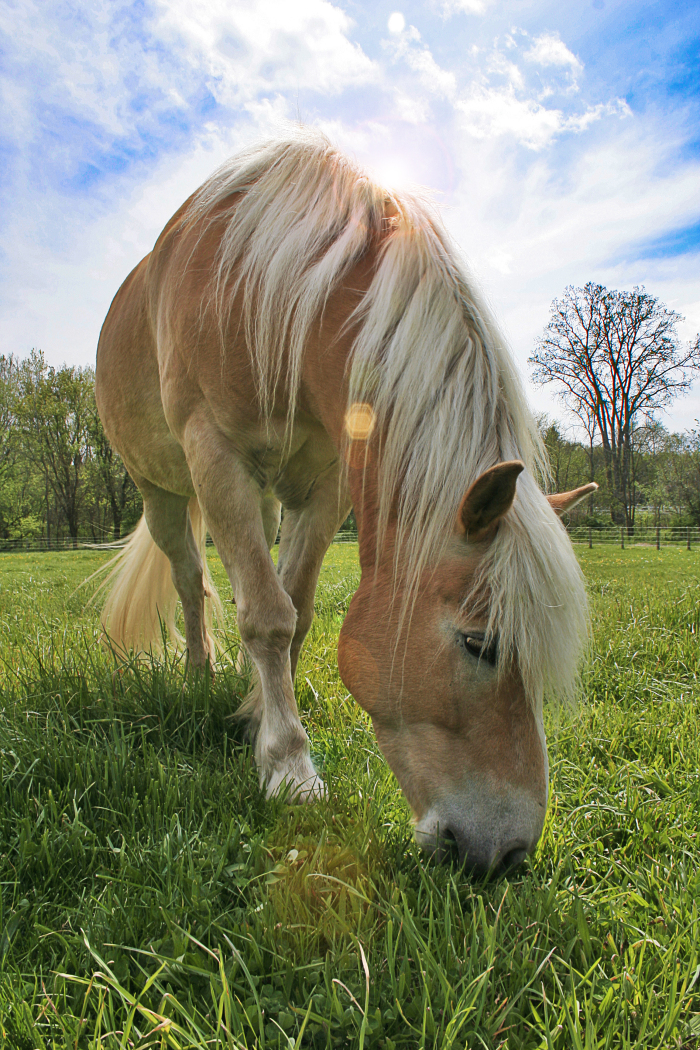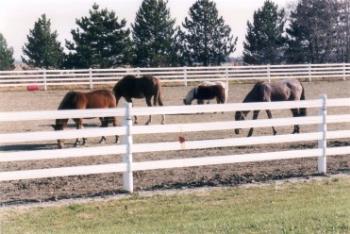
I just love owning horses! And I have had many over the years. From the time I was little and had the best “puppy dog-teacher” horse, to later when I would go to the thoroughbred auctions at the track to find young hunter prospects, I have loved horses. Every horse had their own personality, and every horse had a habit that was unique to that particular horse. Just like us, horses have their own good and not so good sides… I have found that when the day is over and our horses are turned out in their own “living quarters”, what we provide for them to live in will be what we maintain for our beloved horses.

Throughout many years of being a fencer, I have seen many projects that failed to do what the horse owner expected their fence to do for them. To the owner’s dismay, they did not know that what they had created for their horses was a “high traffic” area. We coined this term due to the abuse that the fencing had to withstand until ultimately the fence system failed *. What was needed was a better planned fence layout, otherwise, no fence that is on the market could work. Ultimately it would fail.
These are some of the most common mistakes that can create a high traffic area:
If you have a dry lot, make sure that your horses have enough grass hay to keep them busy. Horses are grazing animals and need to have food if they are in a dry lot for long periods of time. Horses will tend to lean or push on the fence for grass outside of the fence. This will put wear and tear on your fence and posts. Solution: Feed grass hay to the horses through out the day. Consider electric fence with your existing fence system to help save on your fence investment.
If you have foals that you are weaning, or young horses in pasture, be sure that they have room to run and play. If not, they can skid up on the fence and cause wear to your rails after time. Also, this will lead to dirt movement around posts, and expose the lower part of the post and this can create a weak or leaning fence system. Solution: consider having a “baby sitter horse” in with the young horses. The mature horses tend to calm the younger ones and show them how to relax. Also, keep a close eye always on young horses or weanlings. If they start to run excessively or show signs of distress, be sure to be ready to move them to a place where they are calm and relaxed. Sometimes, shorter turnout times and stall time needs to be done twice in a day until young horses learn they have nothing to worry about.
Running the fence line – If you see horses running the fence line, something is distressing them. It’s not good for the horse (they can become overheated or colic) and definitely will wear on your fence. Solution: Once again, try using some grass hay. If it’s hot, be sure horses have fly spray on them. Also provide an area where they can get out of the sun. It could be that you need to put horses together that get along, or need to be with a “buddy” and not alone.
Cross fencing with horses that play on both sides is a high traffic area. The result will be wear from rearing on the rails, kicking through or on the fence, and pushing down on the top rail. Solution: Consider rotational grazing instead of horses on both sides of the fence at the same time. Consider splitting turnout so that only one pasture is used at a time. Or have a day turnout and night turnout with horses in only one pasture at a time. If you must put horses out together in both pastures, use electric down the common fence line. This will help to protect the dollars you have put into your fence.
Small paddocks or small “in and outs” from the barn. Solution: If an area is too small for the amount of turn out time, consider shorter turnout or a larger pasture. I would not consider using electric in any small area of containment. Consider using larger posts and concreting all of them in small areas, and realize that this is will be a high traffic area. Watch for any maintenance that is needed right away. Waiting only leads to broken fencing that could have been protected with early maintenance.
Letting you horse lean over your fence to eat along a natural boundary line. Eventually you will see your fence line lean, causing weak posts and wear to the rails. Solution: Clear the brush from the fence line, or use electric.
Large number of horses waiting to come in at feeding time– Horse’s will congregate when it’s time to eat and can lean on gates and fence. Kicking can occur that can not only hurt your horse, but your fence too. Solution: If your pasture is large enough, consider putting an aisle in. Through design, you can create a “catch area” allowing each pasture of horses in at one time. In the event that the horses are young or excitable, you have a second change to calm them down before just going through a gate to the wide open spaces (walking through the catch area). This gives you the ability to be sure that you can safely lead them to the barn.
If you have cribbing horses– They can literally eat your posts into tooth-picks. Solution: Consider a crib strap. Cribbing is contagious, and horse’s can and will pick up the bad habit. Electric can sometimes help, however, if the horse is a die-hard cribber, it’s next to impossible to cover all the posts and wood in electric.
Putting your rail on the outside of your posts… can be a problem if your horses are leaning on the fence. Rail to the inside is a stronger system because the post acts as a brace for the rail. Solution: Aesthetics can sometimes warrant your rail to the outside, however, be sure you check all brackets frequently so that fence rails are not loose from the post.
Not turning on electric fences – this is something that I see frequently. Electric fence needs to be on at all times to keep the fence in good shape and keep your horses in.
These are just some of the issues that create high traffic areas. I hope to be able to increase your awareness of what your horses are going to do to in high traffic areas and how it will affect the time you put into maintenance.
As horse owners we need to be aware that there is no fence that is 100% horse proof. – Even if you had a concrete wall, your horse could try to clear it and could get injured (and then you would have a loose horse, too). Talk to a professional fencer that knows horses and deals with horses. Find a reputable fencer that is looking out for your best interests and tells you everything about their products as well as what the warranty covers! (FYI – Most flexible fence warranties cover any cracking, peeling, splitting, or discoloration due to weathering or manufacturer’s defects. They do not normally cover abuse. Most rigid PVC fencing is the same, and is not made for horse containment. We recommend electric with any PVC fencing. See manufacturer’s requirements for installation and always ask what warranties they provide before you purchase.)
Get the best information that you can so that you can get the most out of your fence and most importantly, your fence layout. And avoid high traffic areas before you fence! *(A failed fence system means that the fencing is not doing the job of holding in the horses. Not to be confused with a fence that breaks).



